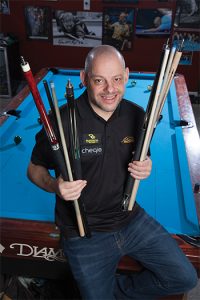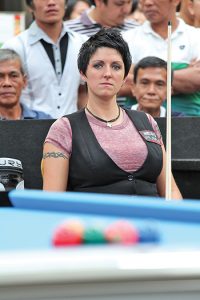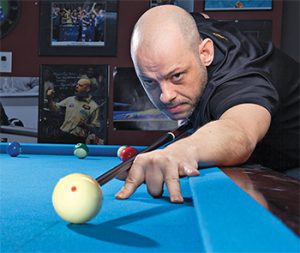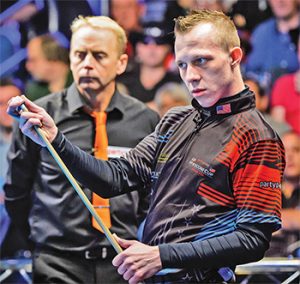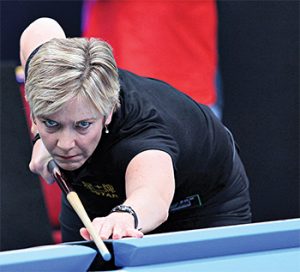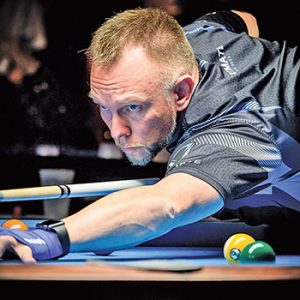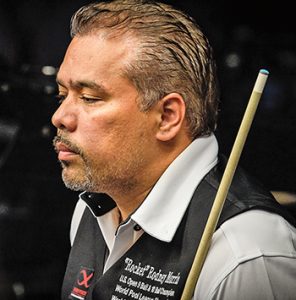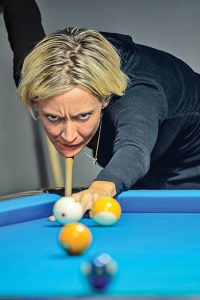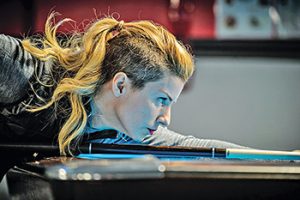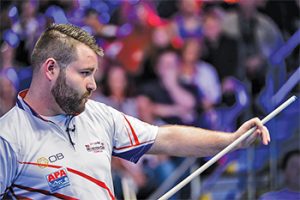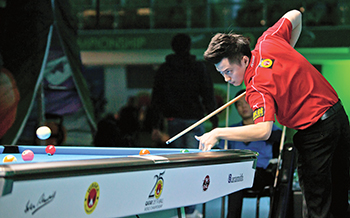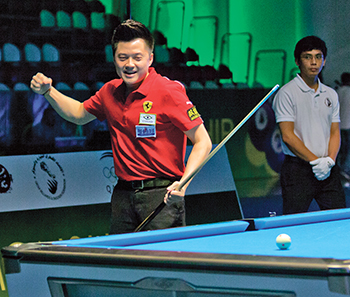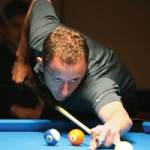KELLY FISHER HOF
Kelly Fisher, already the winner of two world titles and dozens of professional events, thought that overcoming heart surgery and a double mastectomy to win her third world crown in 2019 was the most significant achievement of her storied pool career.
That all changed July 13 when the 41-year-old British native learned that she had been elected into the Billiard Congress of America Hall of Fame.
“It’s hard to explain what I’m feeling right now,” Fisher said from her home in Dumfries, Scotland, after receiving news of her election. “It’s different. It’s not a competition. It’s a reward for all you have accomplished. You win Player of the Year and that’s great. Then you win Player of the Decade and that’s even more rewarding. But to be voted into the Hall of Fame, that is another level completely.”
Fisher was the sole inductee into the 2020 BCA Hall of Fame, garnering votes on 70 percent of the Hall of Fame Board ballots to gain election from a list of eligible players that included first-timers Dennis Orcollo of the Philippines and Thorsten Hohmann of Germany, as well as American Corey Deuel, Dutchman Niels Feijen and six other candidates.
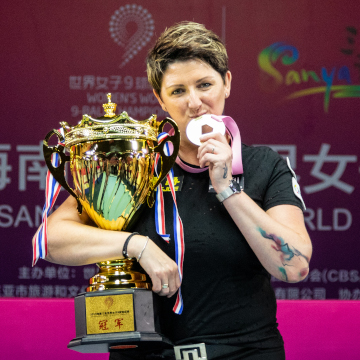
“I remember coming to the U.S. in 2004 and seeing players get into the Hall of Fame over the next few years,” said Fisher. “They’d been playing for many years and won so many titles. I wondered whether I could get to that level. As I got older, the thought of getting into the Hall of Fame became a realistic goal, which would mean the world to me.”
Fisher arrived in the U.S. in 2004 to join the Women’s Professional Billiard Association Classic Tour after having earned six snooker Women’s World Championships over a six-year period from 1997 to 2003. She broke into the WPBA’s Top 10 in less than a year and won her first WPBA title in 2005. She went on to win eight WPBA titles from 2006 to 2010. She reached the WPBA No. 1 ranking in 2008. Fisher captured her first World Pool-Billiard Association (WPA) world title in 2011, when she won the World 10-Ball Championship. A year later, Fisher claimed the World 9-Ball Championship. She also earned four International Tournament of Champions titles, winning in 2009, 2010, 2013 and 2014.
Fisher moved back to England in 2013. In 2014, she underwent surgery to repair a hole in her heart and, a year later, underwent a double mastectomy. She recovered to win professional titles in each of the following three years, before completing her comeback with her second World 9-Ball Championship in late 2019.
“Winning the World 9-Ball Championship last year meant so much to me,” she admitted. “It came out of the blue. I knew I was still capable, but I was over 40 and the quality of play is so high. I remember being very nervous before the final and that surprised me. I had been in many finals, but at that stage you just don’t know how many more chances you’re going to have.” Fisher was named Billiards Digest Player of the Decade for the 2010s.
In her first year of eligibility for the BCA Hall of Fame in 2019, Fisher was edged out by Canadian Alex Pagulayan in a special run-off ballot after the two had tied as top vote getters in the initial election. Both Orcollo and Hohman tallied 23 votes (51 percent) in the 2020 election. Deuel and Feijen were each named on more than 20 percent of the ballots. Shannon Daulton, Jeremy Jones, Stefano Pellinga, John Schmidt, Vivian Villarreal and Charlie Williams completed the 2020 ballot.
Voting for the 2020 BCA Hall of Fame was conducted by the USBMA Hall of Fame Board, which consists of USBMA members, elected At-Large members and living members of the Hall of Fame. To be eligible for consideration in the Greatest Players category, a player a) must be 40 years old by Jan. 1 of the year of their inclusion on the ballot; b) must have a professional playing career of at least 10 years; and c) must have recorded significant achievements in U.S.-based and international events recognized by the BCA.
LION ROARS INTO HALL OF FAME
Over the years, Alex Pagulayan, the comical, mischievous and lethal Canadian-by-way-of-the-Philippines pool star, has parlayed his talents into the World 9-Ball Championship, a U.S. Open 9-Ball title and a pair of Derby City Classic Master of the Table crowns. Those achievements have now earned the 41-year-old “Lion” the “ultimate accomplishment,” induction into the Billiard Congress of America Hall of Fame.
The United States Billiard Media Association announced that Pagulayan will enter the sport’s most exclusive club, along with table manufacturer/promoter Greg Sullivan and Johnston City Hustlers Jamboree creators George and Paul Jansco. All will be formally honored during ceremonies at the Norfolk Sheraton Waterside Hotel in Norfolk, Va., on Friday, Nov. 1.
Pagulayan, who earned election in a run-off against England’s Kelly Fisher after the two had tied on the initial ballot, will enter the Greatest Players wing of the Hall of Fame. Sullivan, 70, and the late Jansco brothers will be honored in the Meritorious Service category.
“I don’t know what to say,” said Pagulayan after being informed of his election. “For a pool player, this is the ultimate accomplishment, right? And I’m happy to become the first Canadian in the BCA Hall of Fame.” Pagulayan, who moved from the Philippines to Toronto at 16, made his presence felt in 2002, when he reached the final of the U.S. Open 9-Ball Championships. After losing to Germany’s Ralf Souquet in the title match, Pagulayan, then 24, reached the final of the World Pool Championship a year later. Again, he lost in the final. Again, he lost to a German player, Thorsten Hohmann. But it was clear that Pagulayan had championship ability, and in 2004 he returned to the title match at the World Pool Championship in Taipei, Taiwan. This time he emerged victorious, topping local hopeful Pei Wei Chang for the title. A year later, Pagulayan exorcised his U.S. Open 9-Ball demon as well, winning the title. In addition to World Summit of Pool and World Pool Masters titles, Pagulayan is the only player to have won titles in all three divisions of the annual Derby City Classic — One-Pocket, Banks and 9-Ball. He also earned Master of the Table titles in 2015 and 2016.
“The Derby City All-Around titles are my biggest career highlights,” Pagulayan said. “They are such big fields and you have to play all three games well. And it’s really hard to win all three disciplines. I feel like I won pool’s triathlon.”
It was the first year of eligibility for both Pagulayan and Fisher. Each were named on 62 percent of the ballots, forcing a run-off vote. In the special election, Pagulayan received 21 votes, while Fisher received 16. Holland’s Niels Feijen (27 percent) and American Corey Deuel (24 percent) were the next highest vote-getters on the initial ballot. Shannon Daulton, Jeremy Jones, Stefano Pellinga, Vivian Villarreal and Charlie Williams were named on less than 10 percent of the ballots.
For Sullivan, admission into the BCA Hall of Fame caps a life of service trying to elevate pool from a recreation to a legitimate professional sport. An Indiana native, Sullivan became a poolroom owner and, with input from top players, began constructing pool tables to professional specifications.
Sullivan launched Diamond Billiard Products, with his tables quickly becoming the preferred playfield of the pros. Frustrated by coin-operated tables that forced players to use magnetic or oversized cue balls, Sullivan is also credited with introducing optical sensor to coin-op tables so that standard cue balls could be used. For Sullivan, it marked another victory in putting professional equipment into the hands of all players.
In the 1990s, Sullivan contracted the Pantone Company to research the optimum color for pool cloth. The testing resulted in the Tournament Blue prevalent in today’s professional tournaments.
As a lifelong fan of the Johnston City Hustler’s Jamborees of the 1960s and ’70s, Sullivan launched a similar multi-discipline event, the Derby City Classic, in 1998. The annual event has drawn thousands of professional and regional players to Southern Indiana for 21 years.
“I have to say, I’m in shock,” Sullivan said when informed. “My whole life has been about pool, just trying to turn it from a game to a sport. It’s all I’ve ever done.”
That George and Paulie Jansco should join Sullivan in the same Hall of Fame class is appropriate, since the Southern Illinois club owners founded the famed Johnston City Hustlers Jamboree and All-Around Pool Championship in the 1960s. The Janscos contributed to the pool’s romanticized image as a gunslinger’s activity. Their promotion of the gambling aspect of the sport contributed to its rise in popularity with the public, with their tournaments drawing media coverage from major television networks and national magazines like “Sports Illustrated.” So popular were the Johnston City events that the Jansco’s launched a second event, the Stardust Open in Las Vegas. The Janscos could also be credited with moving 9-ball and one-pocket into the game’s forefront during a time in which straight pool was considered the only professional game. They were also among the first promoters to welcome integrated fields, paving the way for players like African-American Cicero Murphy to compete for world titles. George Jansco passed away in 1969. Paul Jansco died in 1997.
The Big Time
It’s been 10 years since the International Pool Tour died. How will history judge the short-lived $13 million venture that showed the promise and peril of attempting to bring pool into the big time?
By Nick Leider
It almost seems like a fever dream, now that it’s been a decade since its death. The International Pool Tour, founded and funded by infomercial maven Kevin Trudeau, held four events in 14 months that awarded more than $6 million in prizes. Pool had not seen — and most likely will not see — anything like this in the history of the sport.
Efren Reyes, winner of two tournaments, pocketed $765,000. The matches were live broadcast across Europe in primetime. Players were told of guaranteed income in the six figures.
But now, 10 years after the IPT’s final event, the World Open, left players with little more than IOUs for $3 million, Billiards Digest revisits the IPT’s unbelievable rise and equally astonishing fall. While setting the record straight on what remains one of the most controversial eras in modern pool, one question begs for an answer:
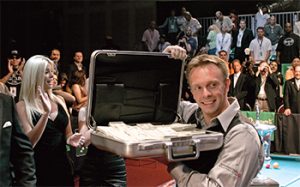
Though short-lived, the IPT still showered pros like Thorsten Hohmann with briefcases full of cash.
What was the IPT’s lasting effect on the game we love?
The Facts
Before telling the story of the IPT, it’s imperative to present the facts that are often lost in the legend of the IPT.
First, every player who won money received what they were due. The $3 million in prizes from the World Open, the abbreviated tour’s last stop, were awarded, though it took 14 months and a series of installments to meet the tour’s obligations.
Second, players did lose $2,000 paid to play in qualifying events for a tournament that never happened. The IPT postponed and then cancelled its future events, leaving those who had ponied up that qualifier money without recourse.
“Some players received that money back and others did not,” said Deno Andrews, the IPT tour director who handled day-to-day operations. “I can’t remember how many ended up losing that money. It was not that many players — with that said, any [number] more than zero was too large.”
Finally, among the top players who competed on IPT, the consensus was that, despite the missteps, broken promises and eventual failure, it was a good thing while it lasted.
“My brothers on tour, we were all really happy about Trudeau and the IPT,” said Rodney Morris, who earned $150,000 with a runner-up finish at that maligned World Open. “We made some money and we had a great time. We were more than happy to be a part of it. We wished things would’ve worked out, but I have nothing against anyone.”
Thorsten Hohmann, who netted $350,000 by winning the North American Open, agrees.
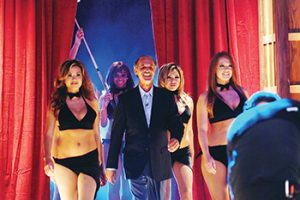
Trudeau’s events were lavish affairs, brimming with pomp and circumstance, as showcased in the Battle of the Sexes match between Loree Jon Hasson and Mike Sigel.
Still, the IPT, coming on so strong and crashing so quickly, affected much more than players’ bank accounts. To see these impacts, it’s worth starting at the beginning.
The First Time
The World Championship Open (Aug. 20, 2005)
Trudeau’s entry into professional sports was a moment of serendipity for pool, a bit of luck for a sport that desperately needed it. The women’s game, buoyed largely by the WPBA Classic Tour, was in decent shape, with events regularly appearing on ESPN and top players able to support themselves with tournament winnings. The men’s side, though, had little as far as organization. The Professional Billiards Tour Association had collapsed in the decade prior. Outside of a few big world championship tilts and the annual U.S. Open 9-Ball Championship, organization was minimal and cooperation was almost nonexistent.
The seeds of the IPT, though, were planted a decade earlier in 1994. Trudeau was already a successful businessman, but he was not yet riding what would be a wave of commercial success based largely on his “Natural Cures” brand, including a New York Times bestselling book and ubiquitous late-night infomercials. Long a fan of pool, he caught a radio advertisement for an exhibition in the Chicago area featuring Hall of Famer Mike Sigel.
“Kevin got in touch with me saying he wanted personal lessons,” Sigel said. “We became friends and I would see him every few weeks. And then I got it in my mind. I said, ‘Hey, you got all this money and you love pool. Let’s do something for the game.’
“I nagged him for 10 years, saying we should do something together. Finally, one day when we were playing pool, he said, ‘Let’s do it.’”
The two scribbled down some notes about prize money. Sigel imagined top prizes around $100,000, with other top finishers pocketing proportionally big bucks. Trudeau, though, had bigger ideas from the start.
“He looked at all that, without even adding it up,” Sigel said, “and he said it’s got to be bigger. For him, from the start, it wasn’t a matter of doing something. It was a matter of how big it was going to be.”
Eventually, the plan was to hold a kickoff challenge match in August 2005 between Sigel and fellow Hall of Famer Loree Jon Jones in Las Vegas. Dubbed the World 8-Ball Championship, the battle of the sexes paid the winner $150,000 with a consolation prize of $75,000. Trudeau threw a lavish party the night before the event, replete with celebrities. On the day of the Sigel-Jones match, the celebrities (actors Paul Sorvino, Allison Janney and Anthony Anderson, rapper DMX and boxing legend Thomas Hearns among them) entered the arena in true red carpet style.
Deno Andrews was taken with Trudeau’s insistence on this being like nothing pool had seen before.
“Everything had to be big. We did nothing half-assed,” Andrews said. “What gets him going is entirely different than what gets the rest of us out of bed. He wanted it big and he wanted it immediately.”
By August, the IPT had crash-landed on the pool world.
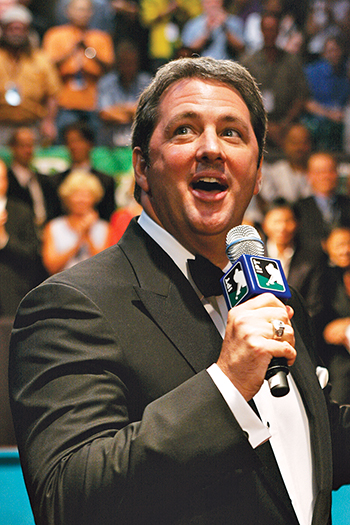
With media maven Trudeau at the helm, “everything had to be big.”
If a guy wanted to get pool players’ attention, big money and bright lights aren’t the worst ways to do so.
The Best of Times
The King of the Hill 8-Ball Shootout (Nov. 30-Dec.4, 2005)
The North American 8-Ball Championship (July 22-30, 2006)
The IPT initially started with 150 players hand selected by Trudeau and the IPT brass. Potential tour members had to apply for a spot on this lucky list, which may be the first and only time pool players put together resumes en masse.
A group of players automatically qualified based on past performance. Think Johnny Archer, Efren Reyes, Rodney Morris and other world-class talents. A dozen living Billiard Congress of America Hall of Famers received automatic entry and a $30,000 bonus simply for being part of the tour. Other players had to apply to tour membership. Darren Appleton, then a professional English 8-ball player but largely unknown in the U.S., emailed his application to the tour hoping that his unmatched record in a slightly different discipline would earn him a spot. (It did.)
The King of the Hill event, however, would only see 42 players compete for the $1 million prize fund, with $200,000 going to the winner. Still, the IPT managed to get all 150 players to Orlando for the event, because a mandatory players meeting promised to detail just what the tour had in store for its first year.
“It was the greatest speech I’ve ever heard,” said Thorsten Hohmann, of Trudeau’s pitch to the players. “It was incredible. I wasn’t really too aware of everything until I got to Orlando and heard Kevin. That made me realize: Holy shit. This is something big.”
Appleton, whose involvement with the tour led to him ditching English 8-ball for the American variety, was equally blown away.
“That players meeting, [there] was amazing excitement. I felt like a professional sportsman,” he said. “This was the biggest thing to happen for pool.”
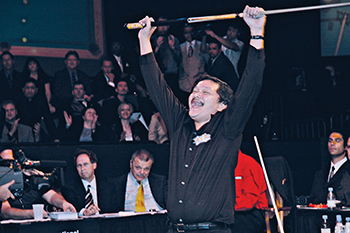
Reyes scored pool’s biggest ever prize.
Six months later, the North American Open brought 200 players to the Venetian in Las Vegas for a chance at the $2 million purse. The top prize was $350,000, the biggest single payday in the history of pool. EuroSport was broadcasting the event live in primetime. Deals were made with Outdoor Living Network to replay the matches for North American audiences. Before a ball was struck, this event was the most significant tournament in years.
The grueling round-robin, multi-round format had players playing four or five race-to-8 sets a day, often clocking more than 12 hours at the table. Hohmann eventually prevailed over Filipino snooker convert Marlon Manalo. But what happened on the table took a backseat to the event itself. The bright lights, the professional production, the class of such an event seemed to mark pool’s arrival as a legitimate sport.
But just two months later, at the IPT’s fourth event, the wheels fell off what everyone thought was pool’s gravy train.
The Worst of Times
The World 8-Ball Championship (Sept. 3-9, 2006)
The World 8-Ball Championship began with Trudeau announcing the cancellation of a scheduled event in London, which had some of the 200 players nervous about what was to come. Regardless, the $3 million prize fund went a long way to relieving any anxiety among the players.
The grueling tournament schedule, again having players compete nearly nonstop for days at a time, left Rodney Morris facing Efren Reyes for the $500,000 top prize. The on-table action ended with the Filipino legend pocketing the top prize while Morris “settled” for $150,000.
Or so it seemed.
All the players left the Grand Sierra Resort and Casino in Reno, Nev., with nothing. Players walked away with promises of future payments, but concerns that were raised at the players meeting became very real for those with a stake in the game.
“That Sunday, Kevin came to me and said the money wasn’t in the bank,” Andrews said. “I’ll never defend him not paying the players. That was wrong and it will go down in history as wrong. But I told him, 100 percent, he needs to pay the players and he said he would.”
Rumors circulated about a proposed deal with Stanley Ho, a billionaire casino magnate based in Hong Kong, to buy the tour. The supposed windfall from this would have supported the tour’s future, Trudeau insisted. But an agreement never materialized. Also, on Oct. 13, 2006, President George W. Bush signed into law the Unlawful Internet Gambling Enforcement Act, which outlawed wagering over the Internet for individuals in the U.S. This, according to the IPT, impacted the tour’s ability to market itself to potential buyers.
Over the course of 14 months, in nine installments of 11 percent, the payments arrived. All the while, no further tournaments were scheduled. The IPT staff, once more than 20 people, was slashed to a skeleton crew of five. Unable to produce profits through events, Andrews pivoted to reducing costs and raising what revenue he could through streaming recorded matches online, selling DVDs and collecting TV and product royalties.
The money wasn’t flooding in, but it was substantial enough to cover roughly half the amount owed to players, according to Andrews, with Trudeau covering the remainder.
“He could’ve filed for bankruptcy,” Andrews said. “He could’ve stiffed the players, but two months after that tournament, I did everything I could to persuade him to commit to paying the players.”
While the payments trickled out, the IPT held seven challenge matches, one-on-one events that were streamed online. The response was tepid and a steep decline from the glitz and glamor of the major tournaments that preceded them. The tour continued on in a sense, but it was evident to everyone within the sport that the IPT of 2007 was a far cry from what the tour had been just months before.
With the future of the IPT falling well short of expectations, Sigel took issue with players who quickly lost faith in the IPT.
“When players started knocking [Trudeau], I couldn’t believe it. That has to leave a bad taste in your mouth,” he said. “That’s when I thought, if it was me, I wouldn’t pay them and just go bankrupt. But he paid him. That’s the kind of guy he was.”
Andrews, however, puts blame on those around the game.
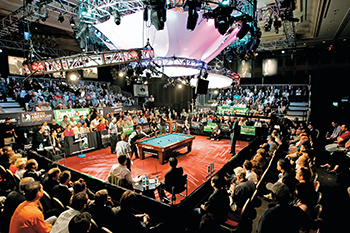
No expense was spared in the production of IPT events, including a sparkling arena to dazzle the masses.
Regardless of where blame lies, those who had the most to gain from the IPT adventure felt a real sense of loss once it was clear things weren’t going to turn out as advertised.
“I had a chance to win $500,000 and then I had to go try to win $10,000?” Morris said. “I lost a lot of motivation. I did a lot of soul searching at that time. For about a year there, I didn’t know what I was going to do. I was depressed for a while.
“It was real hard. I didn’t want to play at all. For a year, I was in a coma. I could’ve been on the “Walking Dead” — just walking around without an idea.”
Hohmann, another player who had profited immensely from the IPT’s short run, expressed similar feelings.
“It wasn’t like the tour ended at once,” he said. “It was a bit of a slow death — them dragging it out with exhibition matches. Of course I fell into a slump … It took me a few years to recover from that. You have these high expectations and then you’re back to playing in tournaments where you’re walking away with $2,000. It was hard.”
The End of Times
Once the players had been paid in full, Andrews met with Trudeau to discuss the IPT. More than $13 million had been invested, including prize money, production costs and marketing. The operation, already stripped to its bare minimum, was barely paying for itself.
The IPT, as it had been packaged from the beginning, was all but dead and buried. At that point, pool’s golden goose decided to pull the plug.
The slow death, as Hohmann put it, had come. But now, in 2016 and a decade after the cash was stacked on the pool table at the first event, the question still remains: Was the IPT a net positive or negative for pool?
“It was good,” Sigel said. “To this day, I defend the IPT whenever I hear someone talk about it. Add up all the money in the years before and after and it won’t come close to the $13 million Kevin put into the game.”
Sigel, who first hatched the concept of the IPT, agrees with Andrews, who was involved in the execution of that idea.
“Ultimately, it was good,” Andrews said. “If you remember what it was like before the IPT, it was very similar to what it is now. It was exactly like it is today … We created an entirely alternate universe for pool. It happened in a vacuum and ultimately I don’t think it had much of an effect on pool. It didn’t impact the actual state of the sport today.”
“He invested an amazing amount of money and it was great,” Appleton said. “I started playing American pool because of the IPT. I have that time to thank for my career and everything I’ve achieved since then.”
“Pool players can be some of the most loyal, trusting and straightforward people,” Andrews said, who continued to work with Trudeau until 2013. “Really the promoters are goofier than the players. The players show up, they pay their expenses, they pay the entry fees, they practice. They do all this stuff, and it’s such a basic thing: Pay them on time.
“I still hear about this. The money isn’t there or the added money was different than what was published … We were as guilty as anybody, but the players were overwhelmingly supportive.”
Van Boening Tops at Super Billiards Expo
But with a new venue and new format, the champion remained Shane Van Boening. The reigning Player of the Year took his fourth Pro Players title, and second in a row, with an impressive run through a field of 61.
Starting with wins over Donnie Mills and Robb Saez, Van Beoning then ran into 2011 champ Ralf Souquet. The American dropped the second set, 8-6, but bounced back with a clinching 8-2 set to advance to the quarterfinals.
Souquet was hardly the only big name to be sidelined early. Efren Reyes drew German superstar Thorsten Hohmann in the first round — and the Filipino legend dropped consecutive sets to end an uncharacteristically quick event. Johnny Archer, Francisco Bustamante and Mika Immonen also crashed out before winning two sets.
In the quarterfinals, Van Boening took two close sets against Darren Appleton; Warren Kiamco edged Corey Deuel; Alex Pagulayan thumped Jeremy Sossei, and Hohmann outlasted Scotland’s Jayson Shaw.
In a rematch from the 2003 World Pool Championship, Hohmann took his spot in the final by edging Pagulayan. Van Boening then topped Kiamco in straight sets, 8-6 and 8-5, to take the other seat in the championship match.
Van Boening struck first in the final, taking the opening set, 8-6. He then worked his way to within a 10-ball of the title in the second when he got on the hill, 7-6. But Hohmann responded with a pair of racks to force a decisive third set.
In the final race-to-8, Van Boening turned a 3-2 lead into an insurmountable 7-2 advantage. Hohmann took a pair of racks to edge within shouting distance at 7-4, but Van Boening then broke and ran the 12th table for the 8-4 win.
His second consecutive Pro Players title netted Van Boening $10,000 while Hohmann pocketed $5,000 for his runner-up finish.
IPT World Open Preview: Talented Tots Wu and Ouschan to Debut
The big news in the first round of the International Pool Tour’s latest multi-million dollar 8-ball tournament will be the debuts of young superstars Chia-Ching Wu of Taiwan and Jasmin Ouschan of Austria, both looking for a big piece of the record-setting $3 million purse.
The eight-day 8-ball event — with a precedent-setting $500,000 first-place prize — kicks off Sunday, Sept. 3, at the Grand Sierra Resort and Casino in Reno, Nev.
Both 17-year-old Wu and 20-year-old Ouschan earned entry into the tournament through the IPT’s rugged qualifier process, and they’re expected to go deep. The precocious Wu is the current WPA world 9-ball and 8-ball champion, and Ouschan topped the star-studded field at the EnjoyPool.com 9-Ball Championship in May.
Otherwise, it looks like smooth sailing for most of the favorites in the first round of the International Pool Tour’s World 8-Ball Open Championship, as the just-released groupings reveal predominantly balanced matchups for the first two days of the event. Top-ranked players were seeded in the field.
Of course, a few players had cause for muttering under their breaths when the groups were announced early Friday. Of the best-known players, Hall-of-Famers and best buddies Ewa Laurance and Loree Jon Jones appear to have their work cut out for them. For that matter, the groupings did no favors for Ouschan, the only female player to have won a spot in an IPT field through the qualifier process.
Expect some surprises. As the players learned in the IPT’s first event of the 2006 season — the North American Open 8-Ball Championship in July — there are dozens of unheralded 8-ball whizzes out there waiting for their big shot, and the 200-player World field features 50 qualifiers who have already proved their mettle.
Look for surprising runs from several Asian qualifiers who now have their feet in the IPT’s door, including Wu from Taiwan (who was seeded 16th in the absence of Filipino Rodolfo Luat), and his countryman Hui-Kai Hsia, a two-time world juniors champion.
The first round will feature 40 groups of five players each. After round-robin play, the top three finishers in each group will proceed to the second round. Eliminated players from the first round will each receive a whopping $5,000.
The complete list of groupings is available at the IPT Web site: www.internationalpooltour.com.
Here are some of the more intriguing brackets from the first round:
Bracket 23 — BD Bloodbath Special: Spectators looking for an exciting bracket to follow should check out this group. No superstars, just tough and hungry veterans: Ivica Putnik (Croatia), Thomas Engert (Germany), Tony Chohan (USA), Tony Drago (Malta), and Zlatko Jakulj (Croatia)
Bracket 1: German sensation Thorsten Hohmann received the top seed by virtue of his $350,000 win at the North American Open, joined here by talented American Steve Moore, Filipino toughie Warren Kiamco, and Americans Jim Raney and Loree Jon Jones. Jones, who survived the first round at the North American Open, will have to bring her “A” game here.
Bracket 26: Austria’s Jasmin Ouschan must contend with Hall-of-Famer Earl Strickland, Swedish veteran Tom Storm, Aruba national champion Roland Acosta and American Pete Fusco. Ouschan regularly hones her skills against the best male players in Europe, so don’t expect her to be intimidated by Strickland, or anyone else in the field, for that matter,
Bracket 18: Hall-of-Famer Ewa Laurance will have her hands full with Australia’s Quinten Hann, the snooker bad boy who finished a surprising 18th at the North American Open; snooker ace Ronnie O’Sullivan from the U.K.; and Jeremy Jones (USA) and Jose Parica (Philippines), both experienced champions who met untimely exits at the North American Open. This bracket will be a dog fight.
Bracket 35: Future Hall-of-Famer Allison Fisher, who was undefeated in the first round of the North American Open, once again has a clean look at the second round. But watch out for qualifier Hui-Kai Hsia of Taiwan and surprising Frenchman Yannick Beaufils. Tough Americans Teddy Garrahan and John Ditoro round out the group, and neither will play patsy.
Bracket 10: Once again, 13-year-old Austin Murphy has a good shot at leaving the first round, this time sharing a bracket with 10th-ranked Darren Appleton (U.K.), Paul Potier (Canada), George San Souci (USA) and Ouahbi Amine (Morocco). Murphy missed the second round at the North American Open by a single rack, losing an 8-7 nailbiter to Danny Basavich. Let’s go, Austin.
Archer is the Champion of Champions
In the final of this year’s winner-take-all $50,000 International Challenge of the Champions, the 2 ball created cartoon-like hijinks, running and hiding from competitors Thorsten Hohmann and Johnny Archer.
Archer eventually put that 2 ball in its place: the pocket, in the single-game tiebreaker, and ran out for the valuable victory.
Archer started the day on Thursday with a match against Marlon Manalo. Manalo took the first set, 5-3, but Archer fought back and won the second set, 5-1, to force a single-game tiebreaker. Archer had been in this same position on Wednesday when he won the lag and proceeded to break and run the tie-breaker rack to eliminate Alex Lely. Once again, Archer won the lag and went on to break and run the single rack to eliminate Manalo and earn Archer a spot in the finals.
Archer’s opponent in the finals was IPT North American Open 8-Ball Champion Hohmann. Hohmann defeated defending champion Fong Pang Chao, 5-1 and 5-3, to earn his spot in the finals.
Hohmann came out strong in the finals against Archer and won the first set, 5-2. The next set was all-Archer as he came back and won the set, 5-1, to force yet another single game tie-breaker to determine the final winner.
Once again, Archer won the lag and made the 1 ball on the break, but the 2 ball began its hide-and-seek game. Archer could only see part of it, so he opted to push and Hohmann played him safe on the 2. Archer took an intentional foul on the, knowing that it was not playable even with ball in hand and Hohmann played another safe on the 2. Archer took on a tough shot that had him elevating his cue and trying to bank the 2 ball into a ball that was near a pocket but was not successful. Fortunately for him, Hohmann found himself dead hooked on the 2 after the balls stopped rolling. Hohmann failed to contact the 2 ball and Archer maneuvered his way through the final rack for the tournament win and $50,000 in prize money.
By Day’s End, One Champion Will Remain at the International Challenge
Day one of the 2006 International Challenge of Champions is complete and the field of eight players has been sliced in half.
Among the elite, international players, every game in the best-of-three matches carried great importance. In the first match of the day, Johnny Archer defeated Alex Lely in a one-game tie breaker to advance.
The second match saw IPT North American 8-Ball Champion Thorsten Hohmann defeat Santos Sambajon, 5-2 and 5-3, to earn his spot in the next round.
The third match of the day featured another single game tie-breaker, as Marlon Manalo came back from a 5-2 loss in the first set and won the second set, 5-2, and then won the tie breaker to eliminate Niels Feijen.
The final match of the day saw defending champion Fong Pang Chao defeat German Ralf Souquet, 5-1 and 5-4, to advance to today’s play.
The match-ups for today should make for an intense climate in the Mohegan Sun Casino in Uncasville, Conn. The first match will feature Archer vs. Manalo at 5 p.m. EST and Hohmann vs. Chao at 6:30 p.m. EST. The winners of those two matches will face each other in the finals at 8 p.m. EST where the winner will pocket $50,000 in this winner-take-all event.
International Challenge of Champions: Bracket’s Up, Rack It Up!
The bracket is drawn for the 2006 International Challenge of Champions and the eight competitors are assessing their chances for the $50,000 first prize.
First round matches begin today, Aug. 9, at the Mohegan Sun Casino in Uncasville, Conn. The first match of the day will take place at 4 p.m. EST as Johnny Archer faces Alex Lely of the Netherlands.
At 5 p.m., IPT North American 8-Ball Champion Thorsten Hohmann will battle 2005 Skins Champion Santos Sambajon.
In the third match of the day at 7 p.m., North American 8-Ball Championship runner-up Marlon Manalo will face ‘The Terminator’ Neils Feijen. Today’s matches will conclude with reigning champion Fong Pang Chao taking on German superstar Ralf Souquet.

